The Interplay of Fashion, Consumerism, and Cities in the Digital Age
VerifiedAdded on 2022/09/08
|10
|2304
|17
Essay
AI Summary
This essay examines the intricate relationship between fashion and consumerism, exploring how fashion has evolved as an aesthetic expression deeply intertwined with societal trends and consumer expectations. It discusses the rise of the fashion industry, its influence on consumer choices, and the impact of mass production on creating a consumerist culture where trends often overshadow factors like quality and durability. The essay further analyzes the role of cities in developing and disseminating fashion trends, particularly through social media and online shopping, highlighting how urban areas foster a sense of conformity to fashionable ideals. By referencing various scholars and studies, the essay provides a comprehensive overview of how fashion shapes individual and societal identities in the modern, capitalist world. Desklib offers a platform for students to access similar essays and study resources to enhance their understanding of fashion and related topics.
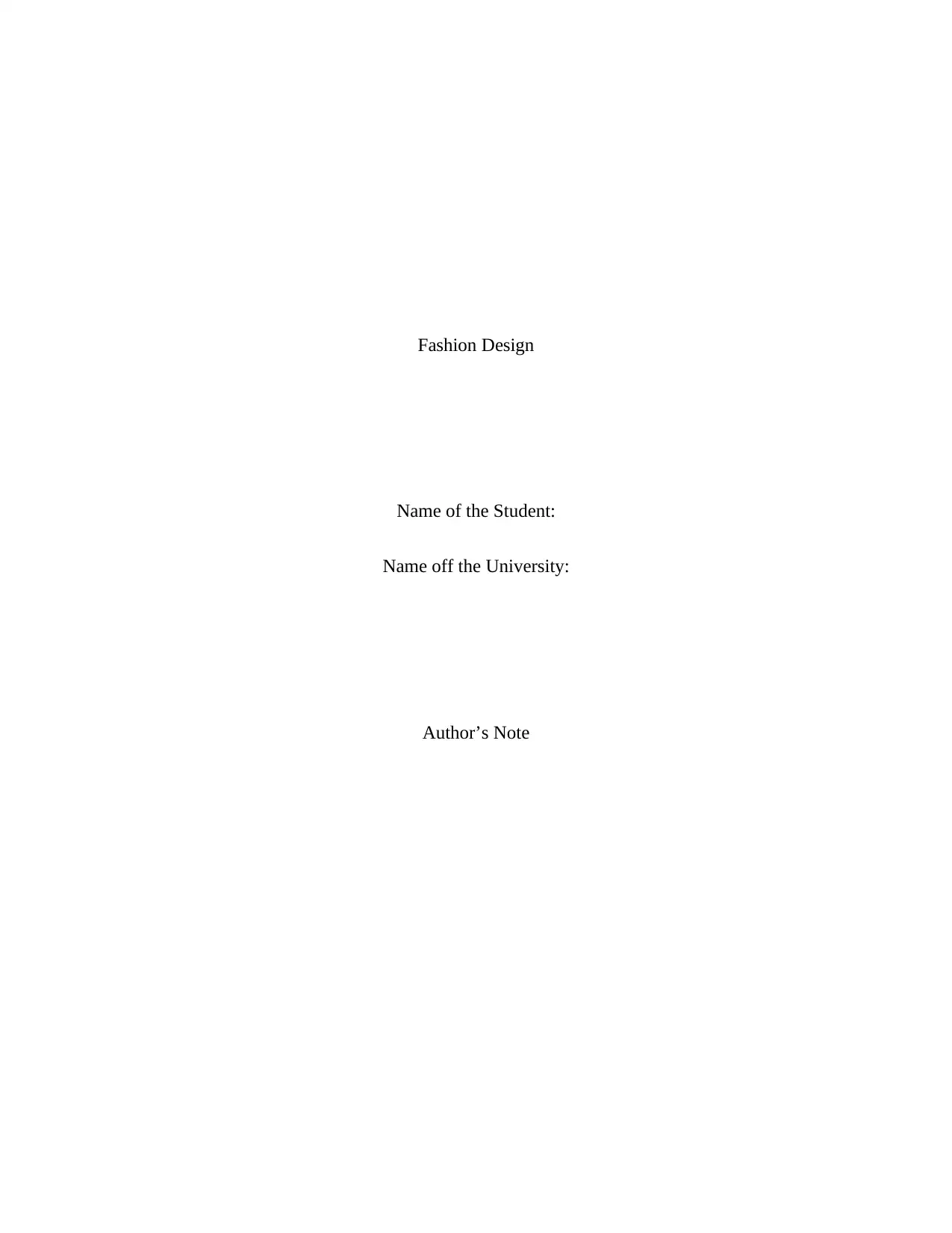
Fashion Design
Name of the Student:
Name off the University:
Author’s Note
Name of the Student:
Name off the University:
Author’s Note
Paraphrase This Document
Need a fresh take? Get an instant paraphrase of this document with our AI Paraphraser
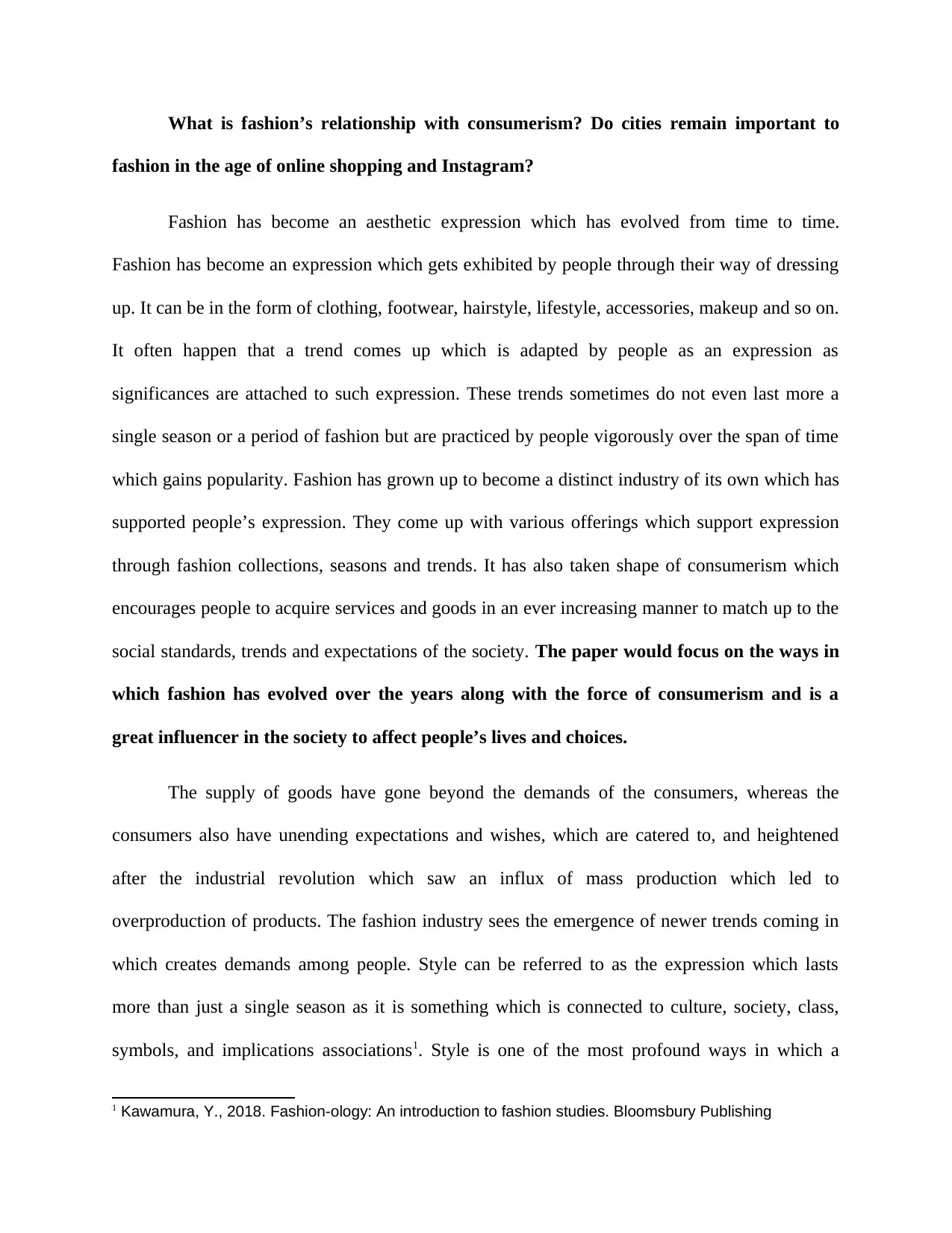
What is fashion’s relationship with consumerism? Do cities remain important to
fashion in the age of online shopping and Instagram?
Fashion has become an aesthetic expression which has evolved from time to time.
Fashion has become an expression which gets exhibited by people through their way of dressing
up. It can be in the form of clothing, footwear, hairstyle, lifestyle, accessories, makeup and so on.
It often happen that a trend comes up which is adapted by people as an expression as
significances are attached to such expression. These trends sometimes do not even last more a
single season or a period of fashion but are practiced by people vigorously over the span of time
which gains popularity. Fashion has grown up to become a distinct industry of its own which has
supported people’s expression. They come up with various offerings which support expression
through fashion collections, seasons and trends. It has also taken shape of consumerism which
encourages people to acquire services and goods in an ever increasing manner to match up to the
social standards, trends and expectations of the society. The paper would focus on the ways in
which fashion has evolved over the years along with the force of consumerism and is a
great influencer in the society to affect people’s lives and choices.
The supply of goods have gone beyond the demands of the consumers, whereas the
consumers also have unending expectations and wishes, which are catered to, and heightened
after the industrial revolution which saw an influx of mass production which led to
overproduction of products. The fashion industry sees the emergence of newer trends coming in
which creates demands among people. Style can be referred to as the expression which lasts
more than just a single season as it is something which is connected to culture, society, class,
symbols, and implications associations1. Style is one of the most profound ways in which a
1 Kawamura, Y., 2018. Fashion-ology: An introduction to fashion studies. Bloomsbury Publishing
fashion in the age of online shopping and Instagram?
Fashion has become an aesthetic expression which has evolved from time to time.
Fashion has become an expression which gets exhibited by people through their way of dressing
up. It can be in the form of clothing, footwear, hairstyle, lifestyle, accessories, makeup and so on.
It often happen that a trend comes up which is adapted by people as an expression as
significances are attached to such expression. These trends sometimes do not even last more a
single season or a period of fashion but are practiced by people vigorously over the span of time
which gains popularity. Fashion has grown up to become a distinct industry of its own which has
supported people’s expression. They come up with various offerings which support expression
through fashion collections, seasons and trends. It has also taken shape of consumerism which
encourages people to acquire services and goods in an ever increasing manner to match up to the
social standards, trends and expectations of the society. The paper would focus on the ways in
which fashion has evolved over the years along with the force of consumerism and is a
great influencer in the society to affect people’s lives and choices.
The supply of goods have gone beyond the demands of the consumers, whereas the
consumers also have unending expectations and wishes, which are catered to, and heightened
after the industrial revolution which saw an influx of mass production which led to
overproduction of products. The fashion industry sees the emergence of newer trends coming in
which creates demands among people. Style can be referred to as the expression which lasts
more than just a single season as it is something which is connected to culture, society, class,
symbols, and implications associations1. Style is one of the most profound ways in which a
1 Kawamura, Y., 2018. Fashion-ology: An introduction to fashion studies. Bloomsbury Publishing

person can be expressive about their taste and how they perceive themselves along with their
sense of getting perceived by people. Fashion and style can be differentiated from one culture
and one type to another and is considered to be a factor based on which differences are made.
Pierre Bourdieu opines that fashion comprises of the latest trends and the differences
which are marked with the fashion trends and changes which shape fashion. Fashion differs from
the mere act of clothing and attires2. It is more associated with senses and understanding of
garments and technical aspects related to the act of dressing up3. For example, it is about how
aptly or exemplarily a person dresses up in an occasion or to assert their sensory appeal in the
form of expression, such as masquerades wears in parties. Fashion has evolved to be a signifier
of the social and temporal system in a context and highlight one’s social position in life, which
activates their sense to be connected to fashion and the societal conformations.
The mass production of commodities have increased expectations and consumer needs, as
the prices of there have been expansion of global reach of products die to the availability of
products online as well as increase of accessibility. Therefore, among most brands, the most
common trend and goal is to achieve stability and sustainability in the market among brands,
fashion trends and consumer4s. The global fashion industry is a notion for the modern day world.
Before the nineteenth century, the clothing needs were mostly met through custom made
clothing. The dresses were either made by individuals by self or by tailors who were specialized
2 Rocamora, A., 2015. PIERRE BOURDIEU. Thinking Through Fashion: A Guide to Key Theorists, 2015,
p.233.
3 Stone, E. and Farnan, S.A., 2018. The dynamics of fashion. Bloomsbury Publishing USA.
4 Welters, L., The fashion of sustainability. Sustainable Fashion: What's Next? A Conversation about
Issues, Practices and Possibilities, 2015. p.4.
sense of getting perceived by people. Fashion and style can be differentiated from one culture
and one type to another and is considered to be a factor based on which differences are made.
Pierre Bourdieu opines that fashion comprises of the latest trends and the differences
which are marked with the fashion trends and changes which shape fashion. Fashion differs from
the mere act of clothing and attires2. It is more associated with senses and understanding of
garments and technical aspects related to the act of dressing up3. For example, it is about how
aptly or exemplarily a person dresses up in an occasion or to assert their sensory appeal in the
form of expression, such as masquerades wears in parties. Fashion has evolved to be a signifier
of the social and temporal system in a context and highlight one’s social position in life, which
activates their sense to be connected to fashion and the societal conformations.
The mass production of commodities have increased expectations and consumer needs, as
the prices of there have been expansion of global reach of products die to the availability of
products online as well as increase of accessibility. Therefore, among most brands, the most
common trend and goal is to achieve stability and sustainability in the market among brands,
fashion trends and consumer4s. The global fashion industry is a notion for the modern day world.
Before the nineteenth century, the clothing needs were mostly met through custom made
clothing. The dresses were either made by individuals by self or by tailors who were specialized
2 Rocamora, A., 2015. PIERRE BOURDIEU. Thinking Through Fashion: A Guide to Key Theorists, 2015,
p.233.
3 Stone, E. and Farnan, S.A., 2018. The dynamics of fashion. Bloomsbury Publishing USA.
4 Welters, L., The fashion of sustainability. Sustainable Fashion: What's Next? A Conversation about
Issues, Practices and Possibilities, 2015. p.4.
⊘ This is a preview!⊘
Do you want full access?
Subscribe today to unlock all pages.

Trusted by 1+ million students worldwide
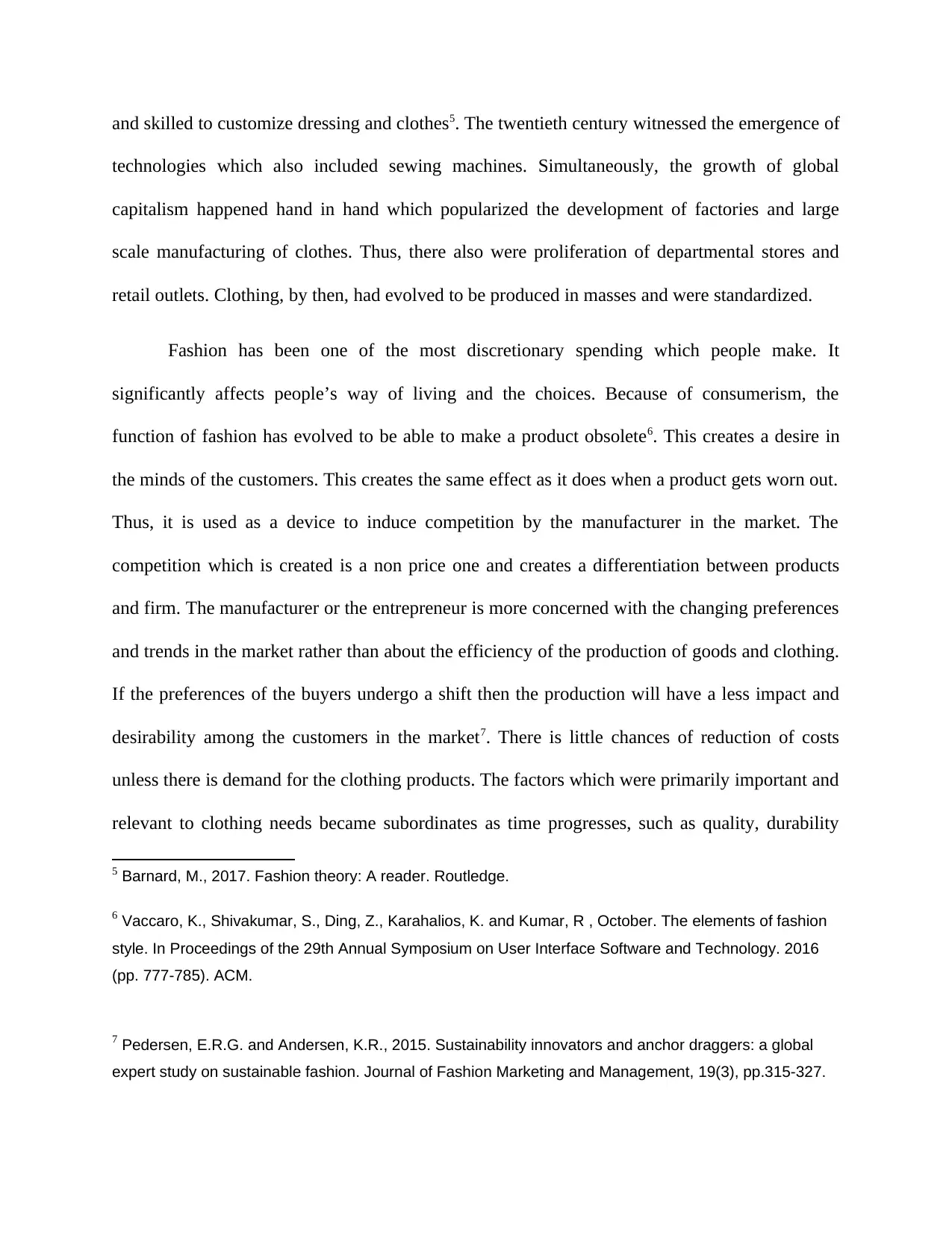
and skilled to customize dressing and clothes5. The twentieth century witnessed the emergence of
technologies which also included sewing machines. Simultaneously, the growth of global
capitalism happened hand in hand which popularized the development of factories and large
scale manufacturing of clothes. Thus, there also were proliferation of departmental stores and
retail outlets. Clothing, by then, had evolved to be produced in masses and were standardized.
Fashion has been one of the most discretionary spending which people make. It
significantly affects people’s way of living and the choices. Because of consumerism, the
function of fashion has evolved to be able to make a product obsolete6. This creates a desire in
the minds of the customers. This creates the same effect as it does when a product gets worn out.
Thus, it is used as a device to induce competition by the manufacturer in the market. The
competition which is created is a non price one and creates a differentiation between products
and firm. The manufacturer or the entrepreneur is more concerned with the changing preferences
and trends in the market rather than about the efficiency of the production of goods and clothing.
If the preferences of the buyers undergo a shift then the production will have a less impact and
desirability among the customers in the market7. There is little chances of reduction of costs
unless there is demand for the clothing products. The factors which were primarily important and
relevant to clothing needs became subordinates as time progresses, such as quality, durability
5 Barnard, M., 2017. Fashion theory: A reader. Routledge.
6 Vaccaro, K., Shivakumar, S., Ding, Z., Karahalios, K. and Kumar, R , October. The elements of fashion
style. In Proceedings of the 29th Annual Symposium on User Interface Software and Technology. 2016
(pp. 777-785). ACM.
7 Pedersen, E.R.G. and Andersen, K.R., 2015. Sustainability innovators and anchor draggers: a global
expert study on sustainable fashion. Journal of Fashion Marketing and Management, 19(3), pp.315-327.
technologies which also included sewing machines. Simultaneously, the growth of global
capitalism happened hand in hand which popularized the development of factories and large
scale manufacturing of clothes. Thus, there also were proliferation of departmental stores and
retail outlets. Clothing, by then, had evolved to be produced in masses and were standardized.
Fashion has been one of the most discretionary spending which people make. It
significantly affects people’s way of living and the choices. Because of consumerism, the
function of fashion has evolved to be able to make a product obsolete6. This creates a desire in
the minds of the customers. This creates the same effect as it does when a product gets worn out.
Thus, it is used as a device to induce competition by the manufacturer in the market. The
competition which is created is a non price one and creates a differentiation between products
and firm. The manufacturer or the entrepreneur is more concerned with the changing preferences
and trends in the market rather than about the efficiency of the production of goods and clothing.
If the preferences of the buyers undergo a shift then the production will have a less impact and
desirability among the customers in the market7. There is little chances of reduction of costs
unless there is demand for the clothing products. The factors which were primarily important and
relevant to clothing needs became subordinates as time progresses, such as quality, durability
5 Barnard, M., 2017. Fashion theory: A reader. Routledge.
6 Vaccaro, K., Shivakumar, S., Ding, Z., Karahalios, K. and Kumar, R , October. The elements of fashion
style. In Proceedings of the 29th Annual Symposium on User Interface Software and Technology. 2016
(pp. 777-785). ACM.
7 Pedersen, E.R.G. and Andersen, K.R., 2015. Sustainability innovators and anchor draggers: a global
expert study on sustainable fashion. Journal of Fashion Marketing and Management, 19(3), pp.315-327.
Paraphrase This Document
Need a fresh take? Get an instant paraphrase of this document with our AI Paraphraser
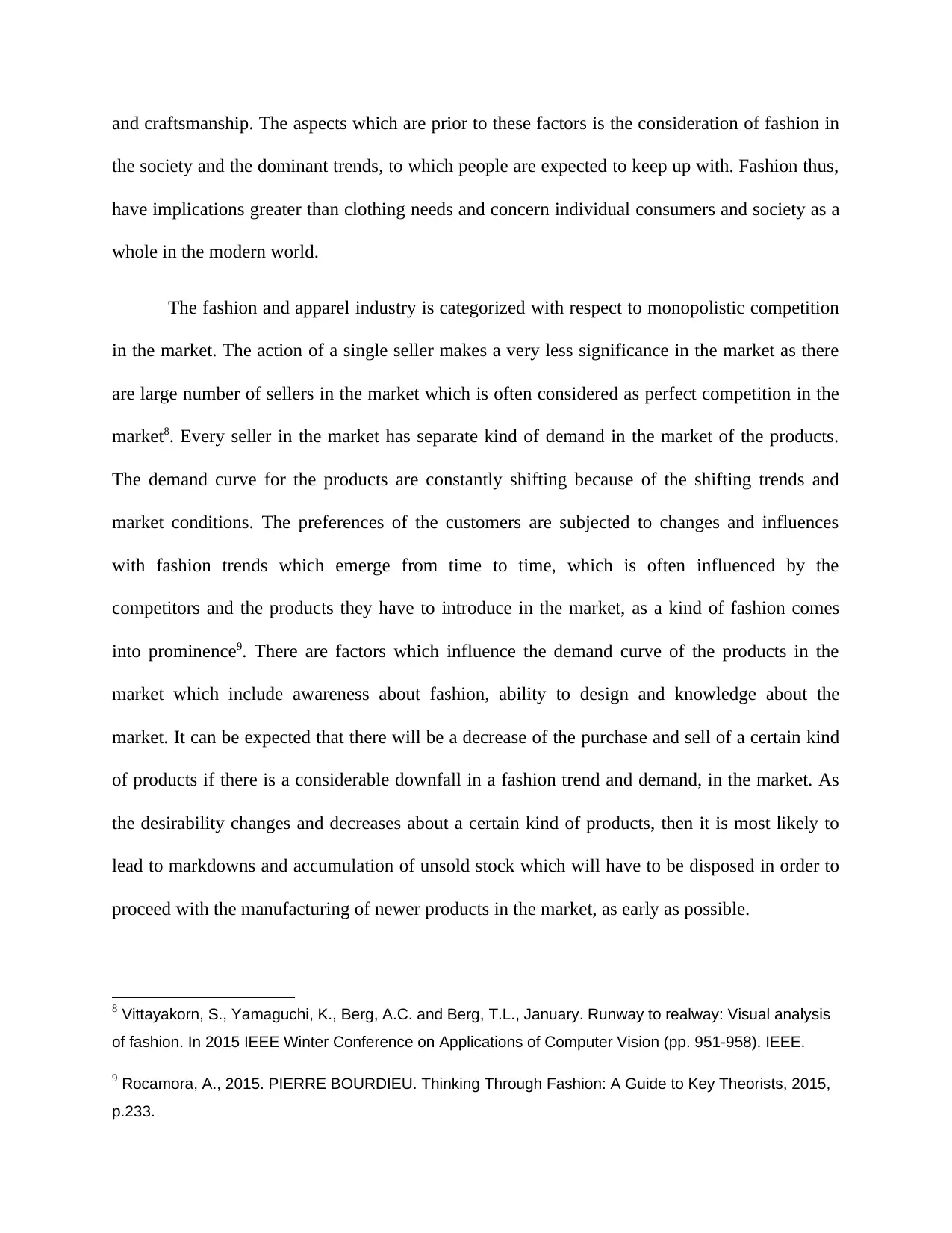
and craftsmanship. The aspects which are prior to these factors is the consideration of fashion in
the society and the dominant trends, to which people are expected to keep up with. Fashion thus,
have implications greater than clothing needs and concern individual consumers and society as a
whole in the modern world.
The fashion and apparel industry is categorized with respect to monopolistic competition
in the market. The action of a single seller makes a very less significance in the market as there
are large number of sellers in the market which is often considered as perfect competition in the
market8. Every seller in the market has separate kind of demand in the market of the products.
The demand curve for the products are constantly shifting because of the shifting trends and
market conditions. The preferences of the customers are subjected to changes and influences
with fashion trends which emerge from time to time, which is often influenced by the
competitors and the products they have to introduce in the market, as a kind of fashion comes
into prominence9. There are factors which influence the demand curve of the products in the
market which include awareness about fashion, ability to design and knowledge about the
market. It can be expected that there will be a decrease of the purchase and sell of a certain kind
of products if there is a considerable downfall in a fashion trend and demand, in the market. As
the desirability changes and decreases about a certain kind of products, then it is most likely to
lead to markdowns and accumulation of unsold stock which will have to be disposed in order to
proceed with the manufacturing of newer products in the market, as early as possible.
8 Vittayakorn, S., Yamaguchi, K., Berg, A.C. and Berg, T.L., January. Runway to realway: Visual analysis
of fashion. In 2015 IEEE Winter Conference on Applications of Computer Vision (pp. 951-958). IEEE.
9 Rocamora, A., 2015. PIERRE BOURDIEU. Thinking Through Fashion: A Guide to Key Theorists, 2015,
p.233.
the society and the dominant trends, to which people are expected to keep up with. Fashion thus,
have implications greater than clothing needs and concern individual consumers and society as a
whole in the modern world.
The fashion and apparel industry is categorized with respect to monopolistic competition
in the market. The action of a single seller makes a very less significance in the market as there
are large number of sellers in the market which is often considered as perfect competition in the
market8. Every seller in the market has separate kind of demand in the market of the products.
The demand curve for the products are constantly shifting because of the shifting trends and
market conditions. The preferences of the customers are subjected to changes and influences
with fashion trends which emerge from time to time, which is often influenced by the
competitors and the products they have to introduce in the market, as a kind of fashion comes
into prominence9. There are factors which influence the demand curve of the products in the
market which include awareness about fashion, ability to design and knowledge about the
market. It can be expected that there will be a decrease of the purchase and sell of a certain kind
of products if there is a considerable downfall in a fashion trend and demand, in the market. As
the desirability changes and decreases about a certain kind of products, then it is most likely to
lead to markdowns and accumulation of unsold stock which will have to be disposed in order to
proceed with the manufacturing of newer products in the market, as early as possible.
8 Vittayakorn, S., Yamaguchi, K., Berg, A.C. and Berg, T.L., January. Runway to realway: Visual analysis
of fashion. In 2015 IEEE Winter Conference on Applications of Computer Vision (pp. 951-958). IEEE.
9 Rocamora, A., 2015. PIERRE BOURDIEU. Thinking Through Fashion: A Guide to Key Theorists, 2015,
p.233.
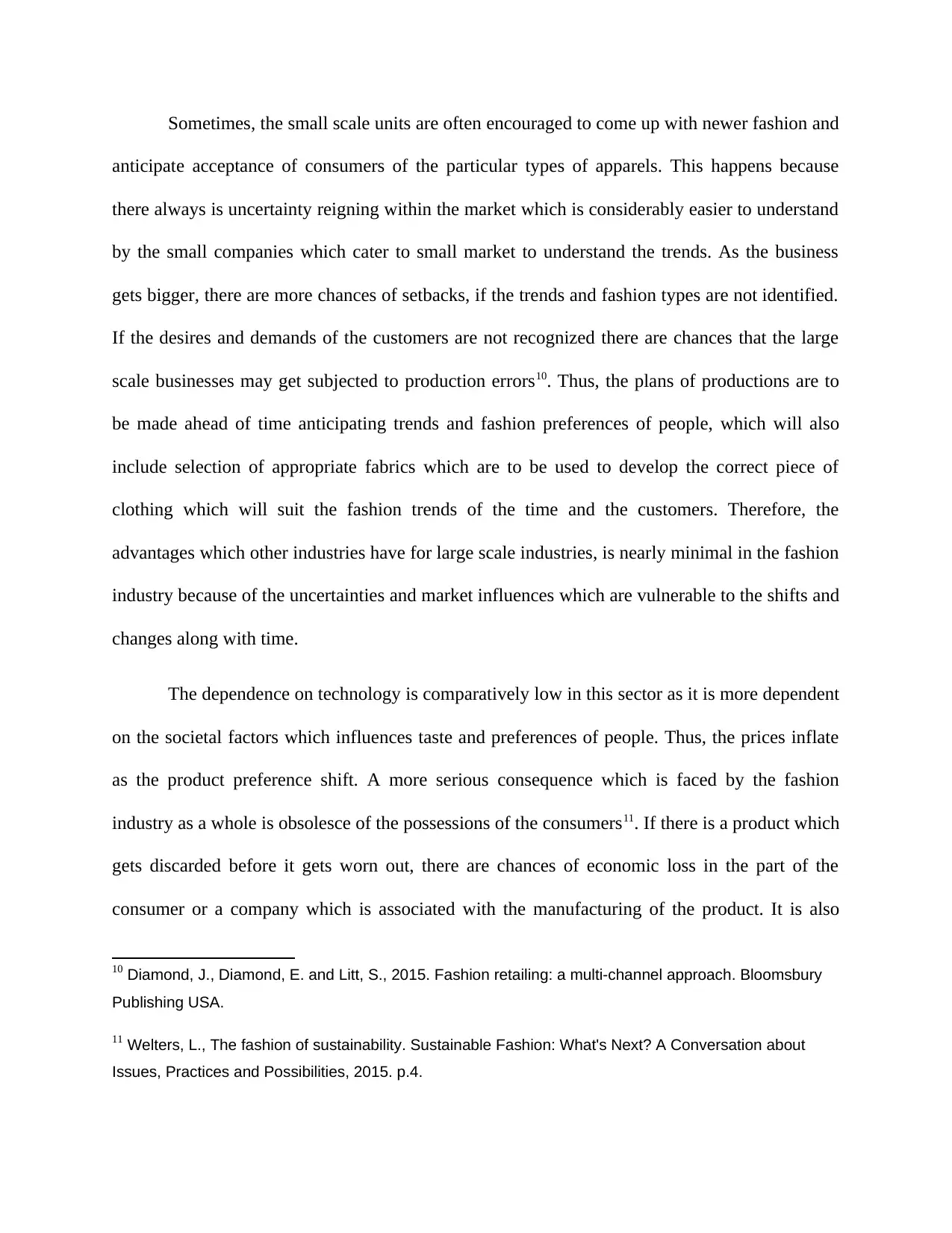
Sometimes, the small scale units are often encouraged to come up with newer fashion and
anticipate acceptance of consumers of the particular types of apparels. This happens because
there always is uncertainty reigning within the market which is considerably easier to understand
by the small companies which cater to small market to understand the trends. As the business
gets bigger, there are more chances of setbacks, if the trends and fashion types are not identified.
If the desires and demands of the customers are not recognized there are chances that the large
scale businesses may get subjected to production errors10. Thus, the plans of productions are to
be made ahead of time anticipating trends and fashion preferences of people, which will also
include selection of appropriate fabrics which are to be used to develop the correct piece of
clothing which will suit the fashion trends of the time and the customers. Therefore, the
advantages which other industries have for large scale industries, is nearly minimal in the fashion
industry because of the uncertainties and market influences which are vulnerable to the shifts and
changes along with time.
The dependence on technology is comparatively low in this sector as it is more dependent
on the societal factors which influences taste and preferences of people. Thus, the prices inflate
as the product preference shift. A more serious consequence which is faced by the fashion
industry as a whole is obsolesce of the possessions of the consumers11. If there is a product which
gets discarded before it gets worn out, there are chances of economic loss in the part of the
consumer or a company which is associated with the manufacturing of the product. It is also
10 Diamond, J., Diamond, E. and Litt, S., 2015. Fashion retailing: a multi-channel approach. Bloomsbury
Publishing USA.
11 Welters, L., The fashion of sustainability. Sustainable Fashion: What's Next? A Conversation about
Issues, Practices and Possibilities, 2015. p.4.
anticipate acceptance of consumers of the particular types of apparels. This happens because
there always is uncertainty reigning within the market which is considerably easier to understand
by the small companies which cater to small market to understand the trends. As the business
gets bigger, there are more chances of setbacks, if the trends and fashion types are not identified.
If the desires and demands of the customers are not recognized there are chances that the large
scale businesses may get subjected to production errors10. Thus, the plans of productions are to
be made ahead of time anticipating trends and fashion preferences of people, which will also
include selection of appropriate fabrics which are to be used to develop the correct piece of
clothing which will suit the fashion trends of the time and the customers. Therefore, the
advantages which other industries have for large scale industries, is nearly minimal in the fashion
industry because of the uncertainties and market influences which are vulnerable to the shifts and
changes along with time.
The dependence on technology is comparatively low in this sector as it is more dependent
on the societal factors which influences taste and preferences of people. Thus, the prices inflate
as the product preference shift. A more serious consequence which is faced by the fashion
industry as a whole is obsolesce of the possessions of the consumers11. If there is a product which
gets discarded before it gets worn out, there are chances of economic loss in the part of the
consumer or a company which is associated with the manufacturing of the product. It is also
10 Diamond, J., Diamond, E. and Litt, S., 2015. Fashion retailing: a multi-channel approach. Bloomsbury
Publishing USA.
11 Welters, L., The fashion of sustainability. Sustainable Fashion: What's Next? A Conversation about
Issues, Practices and Possibilities, 2015. p.4.
⊘ This is a preview!⊘
Do you want full access?
Subscribe today to unlock all pages.

Trusted by 1+ million students worldwide
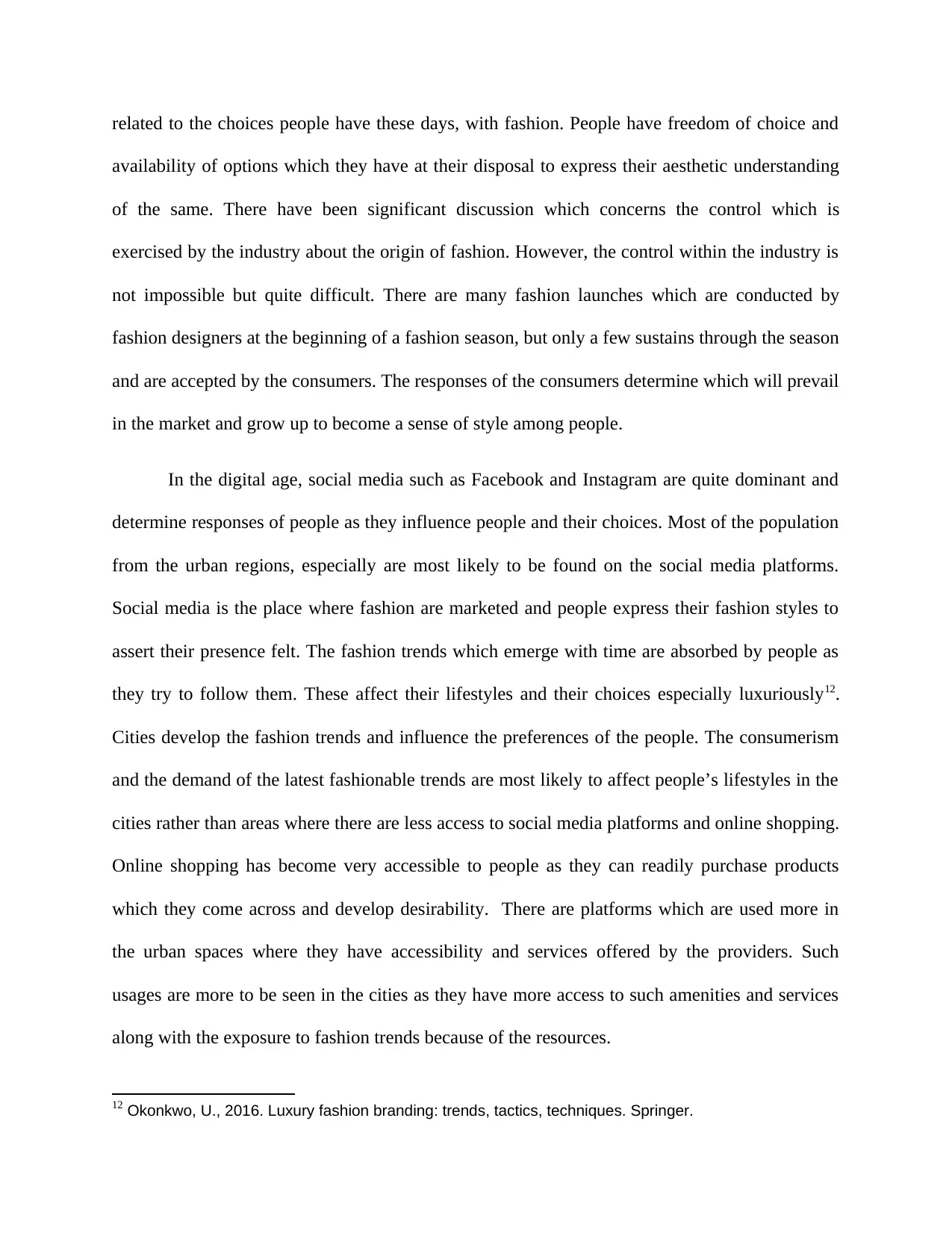
related to the choices people have these days, with fashion. People have freedom of choice and
availability of options which they have at their disposal to express their aesthetic understanding
of the same. There have been significant discussion which concerns the control which is
exercised by the industry about the origin of fashion. However, the control within the industry is
not impossible but quite difficult. There are many fashion launches which are conducted by
fashion designers at the beginning of a fashion season, but only a few sustains through the season
and are accepted by the consumers. The responses of the consumers determine which will prevail
in the market and grow up to become a sense of style among people.
In the digital age, social media such as Facebook and Instagram are quite dominant and
determine responses of people as they influence people and their choices. Most of the population
from the urban regions, especially are most likely to be found on the social media platforms.
Social media is the place where fashion are marketed and people express their fashion styles to
assert their presence felt. The fashion trends which emerge with time are absorbed by people as
they try to follow them. These affect their lifestyles and their choices especially luxuriously12.
Cities develop the fashion trends and influence the preferences of the people. The consumerism
and the demand of the latest fashionable trends are most likely to affect people’s lifestyles in the
cities rather than areas where there are less access to social media platforms and online shopping.
Online shopping has become very accessible to people as they can readily purchase products
which they come across and develop desirability. There are platforms which are used more in
the urban spaces where they have accessibility and services offered by the providers. Such
usages are more to be seen in the cities as they have more access to such amenities and services
along with the exposure to fashion trends because of the resources.
12 Okonkwo, U., 2016. Luxury fashion branding: trends, tactics, techniques. Springer.
availability of options which they have at their disposal to express their aesthetic understanding
of the same. There have been significant discussion which concerns the control which is
exercised by the industry about the origin of fashion. However, the control within the industry is
not impossible but quite difficult. There are many fashion launches which are conducted by
fashion designers at the beginning of a fashion season, but only a few sustains through the season
and are accepted by the consumers. The responses of the consumers determine which will prevail
in the market and grow up to become a sense of style among people.
In the digital age, social media such as Facebook and Instagram are quite dominant and
determine responses of people as they influence people and their choices. Most of the population
from the urban regions, especially are most likely to be found on the social media platforms.
Social media is the place where fashion are marketed and people express their fashion styles to
assert their presence felt. The fashion trends which emerge with time are absorbed by people as
they try to follow them. These affect their lifestyles and their choices especially luxuriously12.
Cities develop the fashion trends and influence the preferences of the people. The consumerism
and the demand of the latest fashionable trends are most likely to affect people’s lifestyles in the
cities rather than areas where there are less access to social media platforms and online shopping.
Online shopping has become very accessible to people as they can readily purchase products
which they come across and develop desirability. There are platforms which are used more in
the urban spaces where they have accessibility and services offered by the providers. Such
usages are more to be seen in the cities as they have more access to such amenities and services
along with the exposure to fashion trends because of the resources.
12 Okonkwo, U., 2016. Luxury fashion branding: trends, tactics, techniques. Springer.
Paraphrase This Document
Need a fresh take? Get an instant paraphrase of this document with our AI Paraphraser
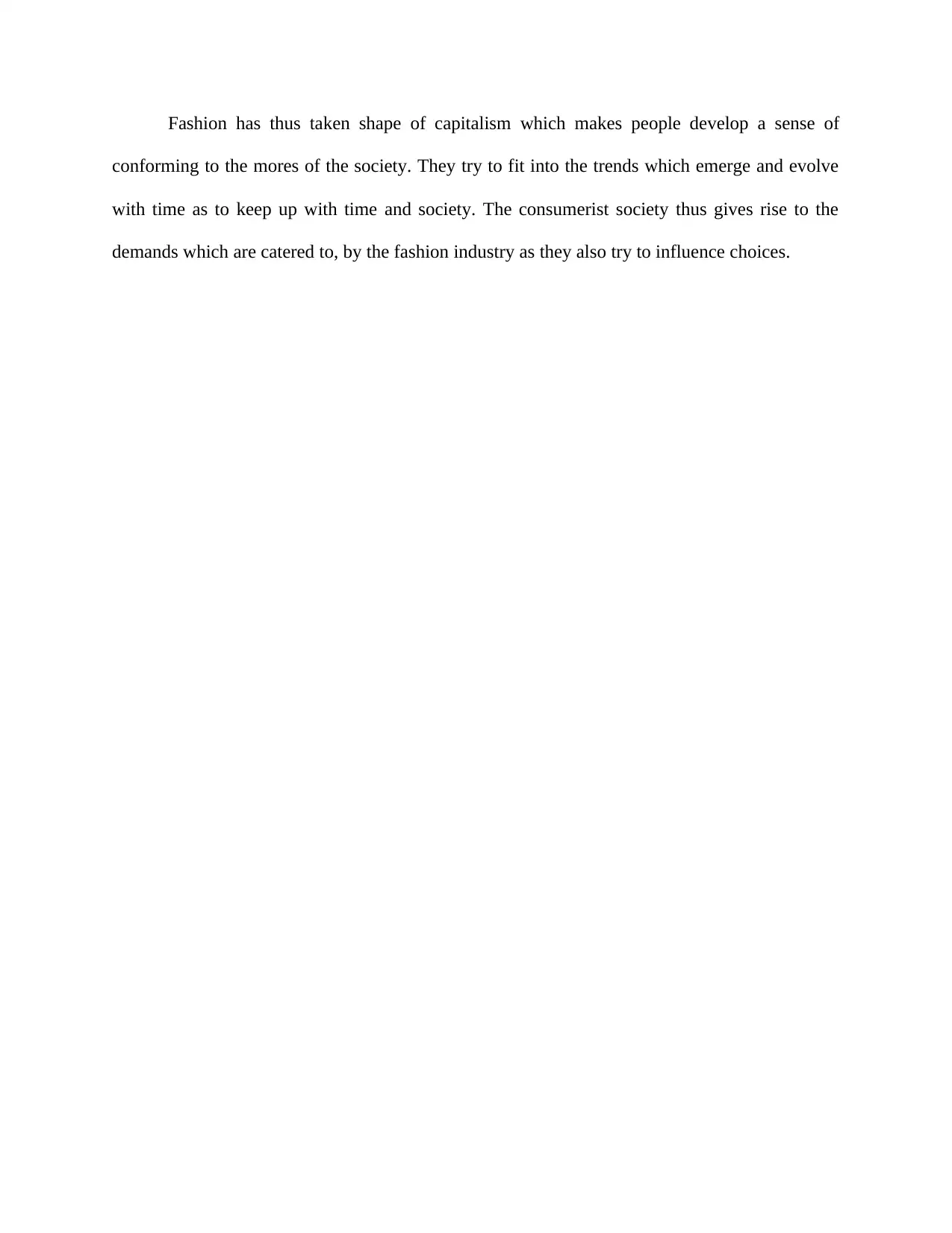
Fashion has thus taken shape of capitalism which makes people develop a sense of
conforming to the mores of the society. They try to fit into the trends which emerge and evolve
with time as to keep up with time and society. The consumerist society thus gives rise to the
demands which are catered to, by the fashion industry as they also try to influence choices.
conforming to the mores of the society. They try to fit into the trends which emerge and evolve
with time as to keep up with time and society. The consumerist society thus gives rise to the
demands which are catered to, by the fashion industry as they also try to influence choices.
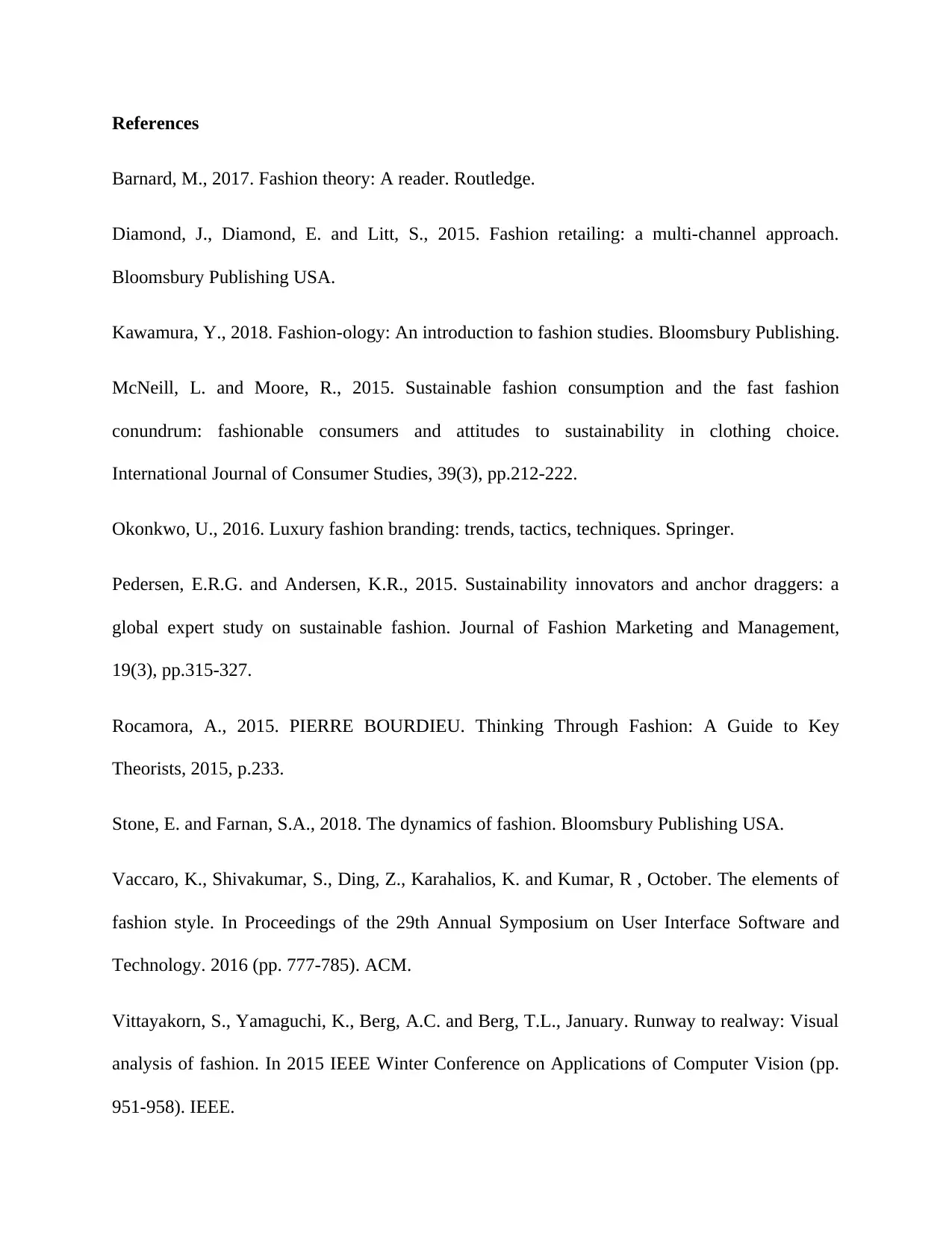
References
Barnard, M., 2017. Fashion theory: A reader. Routledge.
Diamond, J., Diamond, E. and Litt, S., 2015. Fashion retailing: a multi-channel approach.
Bloomsbury Publishing USA.
Kawamura, Y., 2018. Fashion-ology: An introduction to fashion studies. Bloomsbury Publishing.
McNeill, L. and Moore, R., 2015. Sustainable fashion consumption and the fast fashion
conundrum: fashionable consumers and attitudes to sustainability in clothing choice.
International Journal of Consumer Studies, 39(3), pp.212-222.
Okonkwo, U., 2016. Luxury fashion branding: trends, tactics, techniques. Springer.
Pedersen, E.R.G. and Andersen, K.R., 2015. Sustainability innovators and anchor draggers: a
global expert study on sustainable fashion. Journal of Fashion Marketing and Management,
19(3), pp.315-327.
Rocamora, A., 2015. PIERRE BOURDIEU. Thinking Through Fashion: A Guide to Key
Theorists, 2015, p.233.
Stone, E. and Farnan, S.A., 2018. The dynamics of fashion. Bloomsbury Publishing USA.
Vaccaro, K., Shivakumar, S., Ding, Z., Karahalios, K. and Kumar, R , October. The elements of
fashion style. In Proceedings of the 29th Annual Symposium on User Interface Software and
Technology. 2016 (pp. 777-785). ACM.
Vittayakorn, S., Yamaguchi, K., Berg, A.C. and Berg, T.L., January. Runway to realway: Visual
analysis of fashion. In 2015 IEEE Winter Conference on Applications of Computer Vision (pp.
951-958). IEEE.
Barnard, M., 2017. Fashion theory: A reader. Routledge.
Diamond, J., Diamond, E. and Litt, S., 2015. Fashion retailing: a multi-channel approach.
Bloomsbury Publishing USA.
Kawamura, Y., 2018. Fashion-ology: An introduction to fashion studies. Bloomsbury Publishing.
McNeill, L. and Moore, R., 2015. Sustainable fashion consumption and the fast fashion
conundrum: fashionable consumers and attitudes to sustainability in clothing choice.
International Journal of Consumer Studies, 39(3), pp.212-222.
Okonkwo, U., 2016. Luxury fashion branding: trends, tactics, techniques. Springer.
Pedersen, E.R.G. and Andersen, K.R., 2015. Sustainability innovators and anchor draggers: a
global expert study on sustainable fashion. Journal of Fashion Marketing and Management,
19(3), pp.315-327.
Rocamora, A., 2015. PIERRE BOURDIEU. Thinking Through Fashion: A Guide to Key
Theorists, 2015, p.233.
Stone, E. and Farnan, S.A., 2018. The dynamics of fashion. Bloomsbury Publishing USA.
Vaccaro, K., Shivakumar, S., Ding, Z., Karahalios, K. and Kumar, R , October. The elements of
fashion style. In Proceedings of the 29th Annual Symposium on User Interface Software and
Technology. 2016 (pp. 777-785). ACM.
Vittayakorn, S., Yamaguchi, K., Berg, A.C. and Berg, T.L., January. Runway to realway: Visual
analysis of fashion. In 2015 IEEE Winter Conference on Applications of Computer Vision (pp.
951-958). IEEE.
⊘ This is a preview!⊘
Do you want full access?
Subscribe today to unlock all pages.

Trusted by 1+ million students worldwide
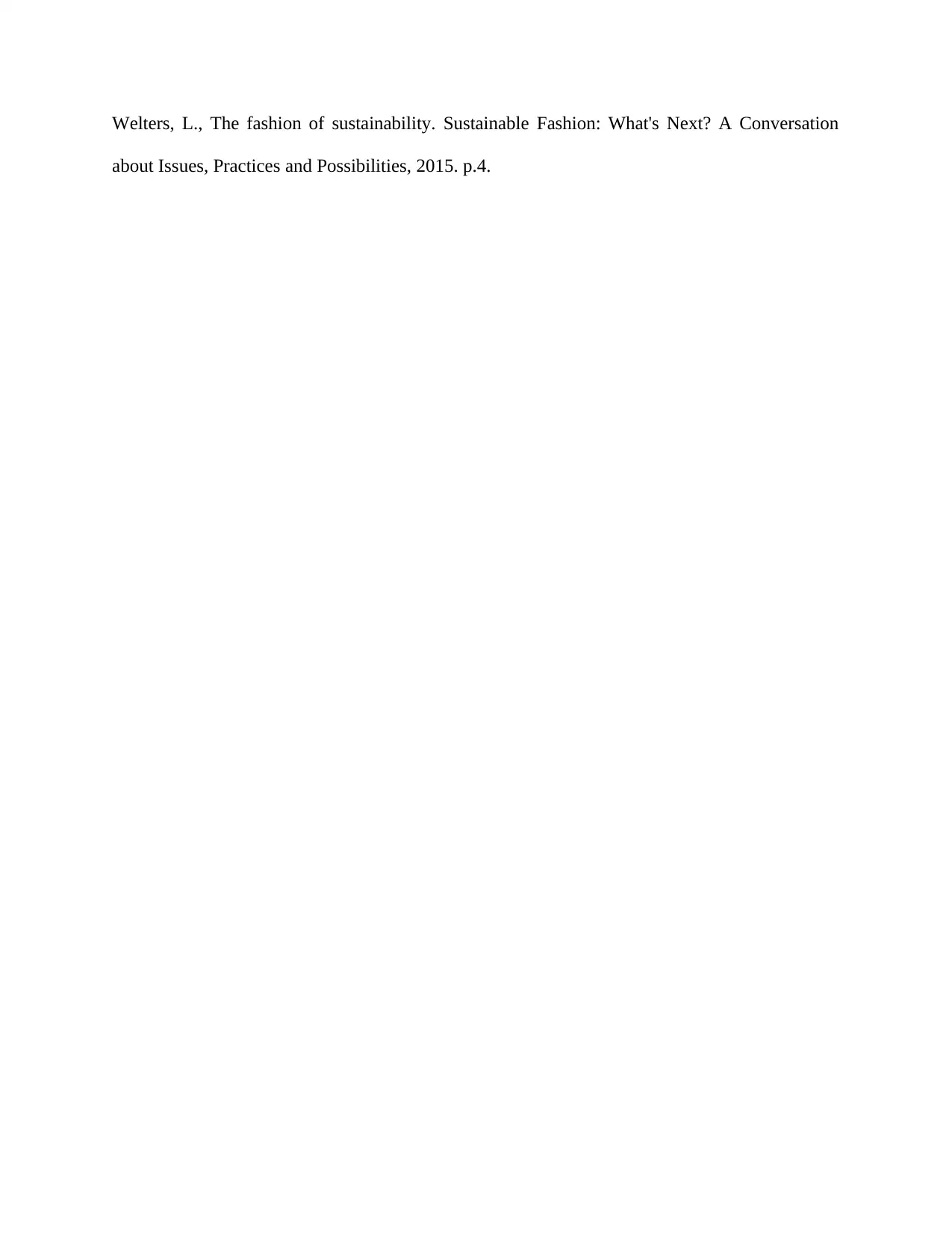
Welters, L., The fashion of sustainability. Sustainable Fashion: What's Next? A Conversation
about Issues, Practices and Possibilities, 2015. p.4.
about Issues, Practices and Possibilities, 2015. p.4.
1 out of 10
Related Documents
Your All-in-One AI-Powered Toolkit for Academic Success.
+13062052269
info@desklib.com
Available 24*7 on WhatsApp / Email
![[object Object]](/_next/static/media/star-bottom.7253800d.svg)
Unlock your academic potential
Copyright © 2020–2025 A2Z Services. All Rights Reserved. Developed and managed by ZUCOL.





